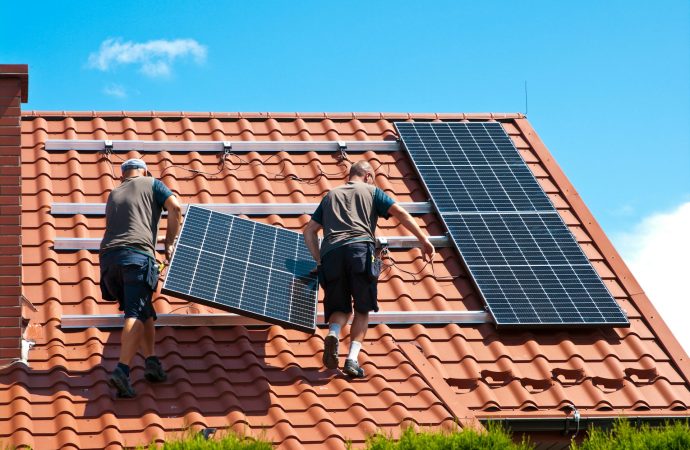Introduction Installing a solar panel system in Pakistan is becoming more popular as electricity prices rise and power cuts become frequent. Solar energy is clean, reliable, and can help reduce your electricity bill in the long run. If you’re thinking about switching to solar power for your home or business, this guide will help you
Introduction
Installing a solar panel system in Pakistan is becoming more popular as electricity prices rise and power cuts become frequent. Solar energy is clean, reliable, and can help reduce your electricity bill in the long run. If you’re thinking about switching to solar power for your home or business, this guide will help you understand each step of the installation process in simple terms.
Step-by-Step Solar Panel Installation Guide in Pakistan
Step 1: Assess Your Energy Needs
The first step is to know how much electricity you use every month. Check your electricity bill to find your average monthly units (kWh). This will help you decide what size of solar system you need. For example:
- A small home may need a 3kW system.
- A medium-sized home might need a 5kW system.
- Larger homes or offices may require 10kW or more.
Knowing your energy needs is very important because it determines the system size, cost, and number of panels.
Step 2: Site Inspection and Roof Evaluation
The next step is to check your rooftop or the area where you plan to install the solar panels. The ideal location should:
- Get sunlight for at least 5 to 6 hours a day.
- Be free of shade from trees or nearby buildings.
- Have a strong and flat surface (for rooftop systems).
In case your roof isn’t suitable, ground-mounted systems can also be used.
Step 3: Choose the Right Type of Solar Panels
There are mainly three types of solar panels available in Pakistan:
- Monocrystalline (high efficiency, higher cost)
- Polycrystalline (moderate efficiency, affordable)
- Bifacial (generate power from both sides)
Choose panels based on your budget, space, and energy needs. For better performance and longer life, many people also pair their solar systems with branded batteries like Osaka. If you’re planning to add batteries, it’s helpful to compare options based on performance and cost, such as checking the osaka battery price in pakistan today to plan your budget accordingly.
Step 4: Select the Right Inverter and Batteries
An inverter is the brain of your solar system. It converts the DC (direct current) electricity produced by the panels into AC (alternating current) electricity used in your home.
Types of inverters:
- On-grid: Connected to WAPDA; no battery.
- Off-grid: Works independently with batteries.
- Hybrid: Works with both grid and batteries.
If you face frequent power cuts, consider a hybrid system with batteries. Batteries store extra energy, which is useful during the night or load shedding.
Step 5: Get Quotations from Solar Installers
Now that you know what type of system you want, it’s time to contact professional solar installers in your city. Ask them for:
- System design based on your needs
- Pricing (with and without batteries)
- Warranty and after-sales service
- Brand options for panels, inverters, and batteries
Compare at least 2–3 companies before making your decision. Reliable installers will provide free surveys and guidance about net metering and maintenance.
Step 6: Installation Process
Once you finalize the installer, they will begin the installation, which usually takes 2–4 days. The steps include:
- Mounting structure installation
- Fixing the solar panels
- Wiring and inverter connection
- Battery setup (if included)
- System testing and activation
Always make sure the installation is done by certified technicians to avoid future issues.
Step 7: Net Metering Application (Optional but Recommended)
Net metering lets you send extra electricity back to the grid and get credit for it. This lowers your bill even more.
To apply for net metering in Pakistan, you’ll need:
- A three-phase meter
- Verified installer’s documents
- Approval from the local electricity company (e.g., LESCO, KE, etc.)
The approval may take a few weeks, but it’s worth it in the long term.
Step 8: Regular Maintenance
Solar systems require very little maintenance. However, you should:
- Clean the panels every 10–15 days
- Check battery water levels (for lead-acid types)
- Monitor system performance monthly
Some companies also offer free annual checkups, so make sure to ask during purchase.
Step 9: Understand the Cost and Payback Period
One of the most important things to consider before installing a solar panel system is the total cost and how long it will take to recover that cost. The price of solar systems in Pakistan depends on the system size, brand, and whether it includes batteries or not.
Here’s a basic price breakdown (as of 2025):
- 3kW system: PKR 450,000 – 550,000
- 5kW system: PKR 750,000 – 950,000
- 10kW system: PKR 1.4 million – 1.7 million
Adding branded batteries like Osaka will increase the cost, but it also improves backup during power outages. That’s why many buyers now compare the osaka battery price in Pakistan today before selecting a solar package.
The payback period for most systems in Pakistan ranges from 3 to 5 years, depending on:
- Electricity unit rates
- Whether net metering is applied
- Energy consumption patterns
- System maintenance
After this period, the electricity you generate is practically free. Plus, solar systems usually last 20–25 years, making them a smart investment.
Final Thoughts
Installing a solar panel system in Pakistan is a smart and sustainable choice. It not only reduces your electricity costs but also increases the value of your property. Whether you’re in Karachi, Lahore, or a rural area, solar energy can provide reliable power for years to come.
If you want to get the most out of your system, make sure to choose quality products and compare market prices, such as checking the osaka battery price in pakistan today, before making your final decision.
















